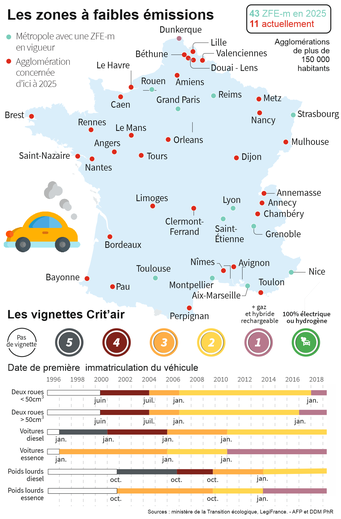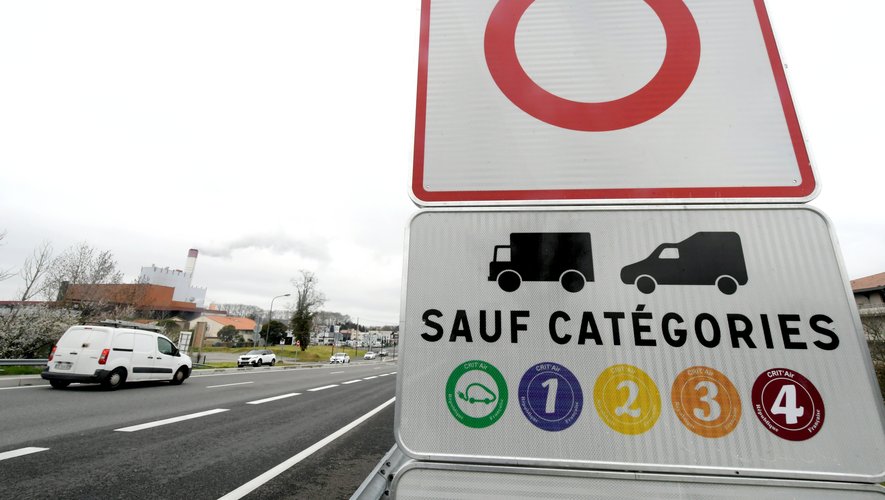To facilitate the acceptance of low mobility emission zones (ZFE-m), which aim to gradually banish the most polluting vehicles from large cities, a Senate report recommends in particular to relax the timetable for restrictions, and to strengthen aid for the purchase of “clean” vehicles.
Discontent has been brewing for nearly two years against ZFEs, low emission zones, which aim to keep the most polluting vehicles out of large cities, i.e. some 13 million cars or motorcycles, categorized according to Crit’air stickers. After the creation of 11 ZFEs in 2019, the Climate and Resilience Law of 2021 provided for their generalization in some 43 agglomerations of more than 150,000 inhabitants in metropolitan France before December 31, 2024. A timetable that worries the French, and arouses the ire of local elected officials who feel they have little support from the state to deploy this measure which directly affects the lives of millions of French people – 60% of whom are still unaware of what ZFEs are…
Shift the ZFE extension schedule
Faced with the growing difficulties encountered by the 11 existing EPZs and by the thirty or so planned by 2025, the Senate’s Regional Planning and Sustainable Development Committee entrusted, last April, Philippe Tabarot, Senator LR des Alpes -Maritimes, the mission to formulate proposals to strengthen the acceptability of this system. A consultation on EPZs, organized on the internet by the commission, met with unprecedented success, with 51,346 responses, which fueled the report presented yesterday.
“Wherever they are set up, m-ZFEs (mobility) come up against tensions and serious misunderstandings, both on the part of the local authorities responsible for setting them up and on the part of users, individuals and professionals, whose daily mobility will be affected by traffic restrictions,” reads a summary of the report. Senator Tabarot notes insufficient support from the State, an offer of alternative transport to the “too modest” car, and the “financially inaccessible nature” of clean vehicles.

Low mobility emission zones (ZFE-m)
Among the nine proposals presented yesterday to the Senate’s Regional Planning and Sustainable Development Committee, the rapporteur Tabarot considers “essential to give more leeway to the agglomerations by making the current timetables more flexible”. Believing that the deadlines are “too close”, he proposes in particular to “set 1 January 2030 as the deadline for the creation of a ZFE-m in agglomerations of more than 150,000 inhabitants, and leaving them the possibility of resorting to more effective and faster alternative solutions”.
“To prohibit from the circulation of the largest metropolises more than a third of the vehicles which cross them daily within a year and a half, inevitably risks digging social and territorial fractures”, he warns.
Increase aid for the acquisition of “clean new” vehicles
Indeed, “the renewal of such a volume of vehicles within such tight deadlines […] seems materially difficult to envisage, given the cost of low-emission vehicles,” he adds. On the other hand, an “essential prerequisite for the deployment of this system” is the existence of a sufficient supply of alternative transport. The senator also recommends strengthening aid for the acquisition of “clean new” vehicles (ecological bonus, conversion bonus), targeting low-income households in particular, and establishing a one-stop shop to simplify obtaining them. Before deploying the system on a larger scale, “a concerted implementation at the regional level must be considered”, he also suggests, in order to avoid too great disparities and to make the rules more readable.
Can these proposals make EPZs more acceptable? In recent months, opposition has been sharp between pro and anti. Among the latter, bikers or the “40 million motorists” association, which launched a petition “so that all vehicles which successfully pass technical inspection can continue to circulate in the ZFEs” and which yesterday said it was satisfied of the Senate report. In January the Rassemblement national tried, in vain, to abolish the ZFEs via a bill.
“The subject is not to hinder the daily life of our fellow citizens”
Supporters of EPZs say they are aware of the difficulties. “On the one hand, the RN’s proposal to ban ZFEs is totally disconnected from the health emergency of fighting air pollution. On the other hand, the government still refuses to massively increase its support for public transport, to limit the remainder to be paid as much as possible for low-income households who have to buy a less polluting vehicle and to force car manufacturers to produce small affordable electric vehicles. indicated the Climate Action Network.
“The figure of 13 million motorists concerned by the obligations imposed by the State is perfectly fanciful. The subject is not to hinder the daily life of our fellow citizens, but to protect them, and in particular the most fragile among us, ”reacted the Minister of Ecological Transition Christophe Béchu.

